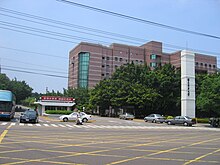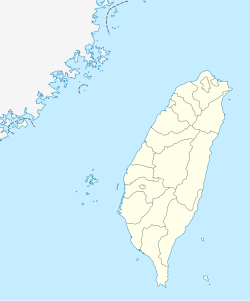|
Hsinchu
Hsinchu (Chinese: 新竹; pinyin: Xīnzhú), officially Hsinchu City,[I] is a city located in northwestern Taiwan. It is the most populous city in Taiwan that is not a special municipality, with estimated 450,655 inhabitants.[3] Hsinchu is a coastal city bordering the Taiwan Strait to the west, Hsinchu County to the north and east, and Miaoli County to the south. Hsinchu is nicknamed the Windy City for its strong northeastern monsoon during the autumn and winter seasons.[4] The area was originally settled by the Austronesian Taiwanese indigenous peoples, with the settlement being named "Tek-kham" by the Hoklo immigrants. The city was founded by Han Chinese settlers in 1711, and renamed "Hsinchu" in 1878. During Japanese rule, the city was named "Shinchiku" and was the seat of Shinchiku Prefecture. The prefecture encompassed present-day Hsinchu City and County, as well as entire Taoyuan and Miaoli. After the ROC rule in 1945, the urban area of Hsinchu was organized as a provincial city. In 1980, the Taiwanese government established the Hsinchu Science Park, an industrial centre for semiconductor manufacturing. The headquarters of TSMC, a semiconductor foundry, MediaTek and United Microelectronics Corporation, are all located in the park.[5][6][7] Besides its industry, Hsinchu is a cultural center of Taiwan.[8] The Chenghuang Temple of Hsinchu, built in 1747, is a common prayer destination. The research institutions of National Yang Ming Chiao Tung University and National Tsing Hua University are both located near the science park.
EtymologyHsin-chu is the Wade-Giles romanization of the Mandarin pronunciation of the Chinese name 新竹. The same name is rendered Xīnzhú in Hanyu Pinyin and Sinjhú in Tongyong Pinyin. This name refers to the settlement's original Hokkien name Tek-chhàm (竹塹),[9] meaning "bamboo barrier".[10] The name may transcribe an aboriginal[which?] name meaning "Seashore".[citation needed] The same name is variously recorded as Teukcham,[11] Teuxham,[11] Tekcham,[12] and Teckcham;[13] its Mandarin pronunciation appears as Chuchien.[10] Hsinchu is popularly nicknamed "The Windy City" for its windy climate[14] and "The Garden City of Culture and Technology" by its tourism department.[10] HistoryEarly settlementThe area around Hsinchu City was inhabited by the Taokas aborigines[citation needed][15] when the Spanish occupied northern Taiwan in the 17th century. Catholic missionaries reached the settlement of Tek-kham in 1626. The Spanish were expelled by the Dutch a few decades later. Qing DynastyUnder the Qing, a Chinese town was established at Tek-kham by Wang Shih-chieh and other Han settlers in 1711.[10] Wang and his party of over 180 people were natives of Kinmen who first camped alongside what is now Dongqian Street in East District, Hsinchu.[16] As part of the reorganization of Taiwan by Shen Baozhen, the viceroy of Liangjiang, Zhuqian Subprefecture (i.e., Tek-kham) was raised to the level of a county and renamed Xinzhu (i.e., Sin-tek or Hsinchu) in 1878.[17] When Taiwan was made a province in 1887, Hsinchu was made a part of Taipeh Prefecture. Japanese rule During the Japanese occupation following the First Sino-Japanese War, the city—known at the time as Shinchiku—was among the province's most populous. In 1904, its 16,371 residents ranked it in 7th place, behind Keelung and ahead of Changhua ("Shoka"). Shinchiku was raised to town status in 1920 and city status in 1930. At the same time, it became the seat of Shinchiku Prefecture. In 1941, its prefecture was expanded, annexing Xiangshan ("Kōzan"). Jiugang ("Kyūminato") and Liujia ("Rokka") merged to become Zhubei ("Chikuhoku"). Republic of ChinaThe Nationalist government of the Republic of China established the Hsinchu City Government in 1945 to oversee all of what had been Shinchiku Prefecture under the Japanese. In 1946, the Take-Over Committee dissolved and replaced by the Hsinchu County Government, located in Taoyuan. As the administrative districts were readjusted, Hsinchu was granted provincial city status. It used the old prefecture office as its city hall at 120 Chung Cheng Road. In February 1946, representative congresses were formed for seven district offices. On 15 April, the city congress was formed. Provincial representatives were elected from among the city legislators. On 16 August 1950, the administrative districts on Taiwan were re-adjusted once more, demarcating 16 counties and 5 provincial cities. In June 1982, under presidential order, the Xiangshan Township of Hsinchu County merged into Hsinchu City. A new municipal government was formally established on 1 July 1982, comprising 103 villages and 1,635 neighborhoods. These were organized into the East, North, and Xiangshan districts by 1 November.[18] By June 1983, the new government consisted of three bureaus (Civil Service, Public Works, and Education), four departments (Finance, Social Welfare, Compulsory Military Service, and Land Affairs), four offices (Secretary, Planning, Personnel, and Auditing), and 49 various sections. The Police Department, Tax Department, and Medicine and Hygiene Department were considered affiliate institutions. From 1994 to 1999, as Taiwan made its transition from authoritarian rule to a representative democracy and the mostly pro forma provincial level of government began to be dissolved, regulations were established for the self-government of Hsinchu. A deputy mayor, consumer officer, and three consultants were added to the city government. In 2002, the city added a Bureau of Labor and transferred Compulsory Military Service to the Department of Civil Service. A movement is underway from 2021 to have Hsinchu City and Hsinchu County to be upgraded to the nation's seventh special municipality.[19] GeographyThe city is bordered by Hsinchu County to the north and east, Miaoli County to the south, and the Taiwan Strait to the west. ClimateHsinchu's climate is humid subtropical (Koppen: Cfa). The city is located in a part of the island that has a rainy season that lasts from February to September, with the heaviest time coming late April through August during the southwest monsoon, and also experiences heavy "plum rains" in May and early June.[20] The city succumbs to hot humid weather from June until September, while October to December are arguably the most pleasant times of year. Hsinchu is affected by easterly winds off of the East China Sea. Natural hazards such as typhoons and earthquakes are common in the region.[21][22][23]
Government  
Hsinchu City is administered as a city. North District is the seat of Hsinchu City which houses the Hsinchu City Government and Hsinchu City Council. The incumbent acting Mayor is Andy Chiu of the Taiwan People's Party. Administrative divisionsHsinchu has 3 districts (區):[29][30]
Colors indicate the common language status of Hakka within each division. PoliticsThe city was historically pan-Blue[citation needed] but in recent years,[when?] the pan-Green coalition has started to rise in popularity. As a result, local factions have decreased in power, and political parties have greater importance in local elections.[31][not specific enough to verify] Hsinchu City elected a Kuomintang legislator, Cheng Cheng-chien, as its representative in the Legislative Yuan during the 2020 Taiwan general election, flipping the seat from the Democratic Progressive Party. Cheng won reelection in the 2024 election. In July 2024, then-Mayor Ann Kao was suspended from her duties and sentenced to prison for violating the Anti-Corruption Act and the Criminal Code.[32] Deputy Mayor Andy Chiu subsequently assumed the duties of Mayor. EconomyThe Hsinchu Science Park has around 360 companies.[33] The purpose of the park is to attract high-tech investment to Taiwan. Since its establishment in 1978, the government has invested over NT$30 billion in software and hardware ventures. In 2001, it developed 2.5 km2 (0.97 sq mi) of land in the park and 0.5 km2 (0.19 sq mi) in southern Hsinchu.[citation needed] The semiconductor and related electronic businesses have faced competition from South Korea and the United States. This has resulted in lower profits and an oversupply of some electronic products, such as memory and semiconductors.[citation needed] In 2020, Hsinchu was classified as a "Sufficiency" level global city by the Globalization and World Cities Research Network.[34] Education  Hsinchu City is one of the most focused educational centers in northern Taiwan. It has six universities in this concentrated area, and among these universities, National Yang Ming Chiao Tung University and National Tsing Hua University are focused on by the government of Taiwan. Other public and private educational institutions in the city included 33 elementary schools, 19 middle schools, 12 high schools and a complete secondary school.[citation needed] International schools (grade school and secondary school)
High Schools
Universities
Tourist attractions  Some tourist attractions in Hsinchu include:
SportsTaiwan's Chinese Professional Baseball League has a professional baseball team, Wei Chuan Dragons, based in Hsinchu.[41] Major sporting events held by Hsinchu include: Transportation  RailHsinchu City is mainly served by Hsinchu railway station, along with five other minor TRA stations on both the Western Trunk line and the Neiwan line. There is also an HSR station in nearby Zhubei, Hsinchu County on Taiwan High Speed Rail. CyclingHsinchu City has recently created a series of cycling routes. Hsinchu is home to many cycling clubs. Sea portsFishing ports are located at Nanliao Street, North District, and Haishan, Xiangshan. AirportHsinchu Airport is located in the North District and is mainly used as a military airbase. The nearest international airport is Taoyuan International Airport, which is located 58 km away from the city. Notable people
International relationsTwin towns – sister cities
See alsoNotesWords in native languagesReferences
External links
|
||||||||||||||||||||||||||||||||||||||||||||||||||||||||||||||||||||||||||||||||||||||||||||||||||||||||||||||||||||||||||||||||||||||||||||||||||||||||||||||||||||||||||||||||||||||||||||||||||||||||||||||||||||||||||||||||||||||||||||||||||||||||||||||||||||||||||||||||||||||||||||||||||||||||||||||||||||||||||||||||||||||||||||||||||||||||||||||||||||||||||||||||||||||||||||||||||||||||||||||||||||||||||||||||||||||||||||||||||||||||||||||||||||||||||||||||||











